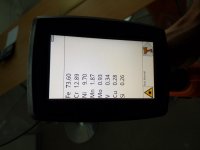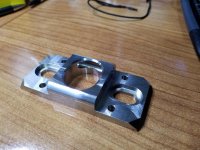Matt_Maguire
Stainless
- Joined
- Oct 17, 2011
- Location
- West-Central Illinois, USA
I think I’d go back to the instability you mentioned in your first post Jashley. The proof would be if an M10, 33 or 36 cobalt HSS could run 5D at the proper speed with a 130-135° crankshaft grind. I have a feeling that a high speed machine with a part weight limit like that Mori is not going to work well with the variable load and inserted drill would drive into it. A box way machine would likely knock down instability a lot.
There isn’t anything that jumps at me about the chemistry. Looks like it’s not sure if it’s hot work (that gets a little harder) or an air hard (that won’t get as hard)… The recipes running 100-125sfpm are pretty much the safe zone for the D types or A7, it should run near 50% faster if it really is annealed. The closest matches I could find in ASM was AISI-SAE 6H2 with .55C, .40Mn, 1.10Si, 5.00Cr & 1.50Mo (absolutely nothing about what it was used for or machinability in the index though).
Slightly jacked up with similar moly would be Crucible Versasteel with 1.00C, .30Mn, 2.00Si, 4.25Cr, 1.15V, 2.5Mo & .30W (machines somewhat easier than annealed HSS per their docs). The stuff is useful for different things at from 58 to 65Rc.
Good luck,
Matt
There isn’t anything that jumps at me about the chemistry. Looks like it’s not sure if it’s hot work (that gets a little harder) or an air hard (that won’t get as hard)… The recipes running 100-125sfpm are pretty much the safe zone for the D types or A7, it should run near 50% faster if it really is annealed. The closest matches I could find in ASM was AISI-SAE 6H2 with .55C, .40Mn, 1.10Si, 5.00Cr & 1.50Mo (absolutely nothing about what it was used for or machinability in the index though).
Slightly jacked up with similar moly would be Crucible Versasteel with 1.00C, .30Mn, 2.00Si, 4.25Cr, 1.15V, 2.5Mo & .30W (machines somewhat easier than annealed HSS per their docs). The stuff is useful for different things at from 58 to 65Rc.
Good luck,
Matt






